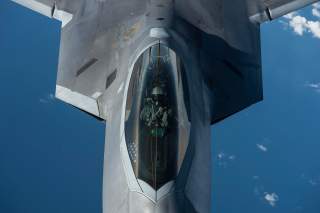The U.S. Air Force Is Giving the F-22 a New Job: Sniper
Think of the F-22 like a sniper — it can use force if needed, but its primary job in the Middle East is to provide overwatch.
Three years ago, four F-22 Raptors taking part in the second-wave of the U.S.-led coalition’s opening airstrikes on Islamic State in Syria dropped their bombs. It was the first time the stealthy fifth-generation fighters had ever engaged in combat. The coalition’s war planners also used the F-22s to leverage their low-observable profiles — and far-reaching sensors — while escorting non-stealthy fighters in case Syrian fighters or air-defense systems engaged.
Fortunately, the Syrian military held its fire.
Fast forward to today, and F-22 Raptors are still flying over Iraq and Syria and have shifted almost fully into that latter role, according to Air Force Magazine. “When we first got here, we were 95 percent precision strike. And now we’re probably 95 percent air superiority,” Lt. Col. “Shell” — a callsign — of the 27th Expeditionary Fighter Squadron told the magazine.
Air superiority is what Lockheed Martin and the Air Force designed the F-22 to do. But in practice over the Middle East, this mission normally means acting as a scout. Lt. Col. “Shell” elaborated to the magazine that the Raptors are in the air helping “deconflict” the airspace, and helping keep Russian and Syrian planes away from U.S. troops and the Syrian Democratic Forces, an alliance of militias spearheaded by the majority-Kurdish People’s Protection Units.
The F-22 can do it because of its complex suite of active and passive sensors, which combined with instruments, allow the aircraft to “fuse” data together and present it to the pilot on a display screen. As well, this allows the Raptor to stand in for command-and-control aircraft such as the E-3 AWACS, with pilots scanning the area and feeding information to other friendly aircraft whenever anything pertinent pops up — while also warning Russian aircraft to keep away over radio if they come too close.
When coalition attack aircraft approach their targets, the Raptors help guide them in.
Think of the F-22 like a sniper — it can use force if needed, but its primary job in the Middle East is to provide overwatch. Case in point, in August 2016, F-22s chased after Syrian Su-24 attack jets when they approached where American commandos were operating in northeastern Syria. The F-22’s stealthiness also allows the twin-engine jet to get closer to potentially hostile aircraft or surface-to-air missile sites with less likelihood of being spotted.
The F-22 is already a mature aircraft — which makes its presence in the war an interesting moment. Having first flown in 1997, the Air Force plans to keep the clipped delta-wing fighters in service for at least 43 more years since the airframes are tough and haven’t been used heavily.
“We came to find out we have not been flying the Raptor nearly as hard as those design missions [in the 1980s-1990s] nor as what we found out during the structural testing, so actually the airframe itself — without any service life extension program — is good out to approximately 2060,” Tom McIntyre, an Air Combat Command program analyst, told the House Armed Services Committee in June 2017.
Regardless, there are no more Raptors coming, as building more would likely be prohibitively expensive since the production lines have closed down. The plane’s computer hardware is from the early 1990s and many of the components are longer made. The Air Force position is that it doesn’t make sense to restart F-22 production when it’s buying more than 1,700 stealthy F-35A Joint Strike Fighters which possess a whole new array of technologies.
The flying branch only bought 187 operational Raptors — out of an original goal of 381.
The F-22 also won’t fly into the 2060s without upgrades. In the government’s 2018 fiscal year budget, the stealth plane will get $1 billion for this purpose, which could possibly include new radars, antennas and avionics to include displays, datalinks and cryptographic software.
The Air Force could take stealth features from the F-35 and apply them to the F-22.
Pilots could get helmet-mounted cueing systems, which allows the pilot to target weapons where she or he is looking — the Air Force announced Raptor pilots would receive a high-tech helmet called Scorpion, but never fielded it. It’s not entirely clear whether F-22 pilots would want one, as these helmets — such as on the F-35 — are heavy and potentially dangerous in the event of an ejection.
But the pilots love their Raptors, and if their watchful presence over Iraq and Syria is any indication, so does the Air Force.
This first appeared in WarIsBoring here.

